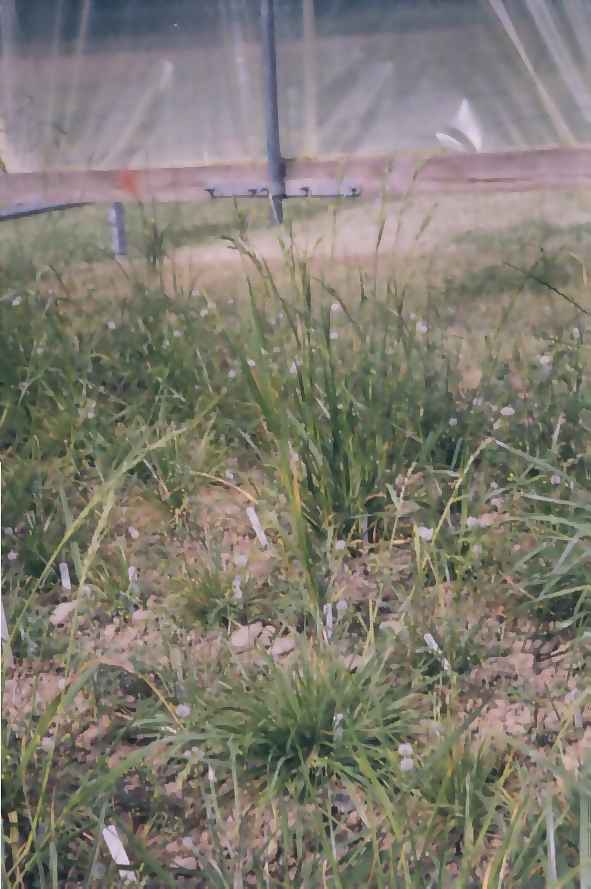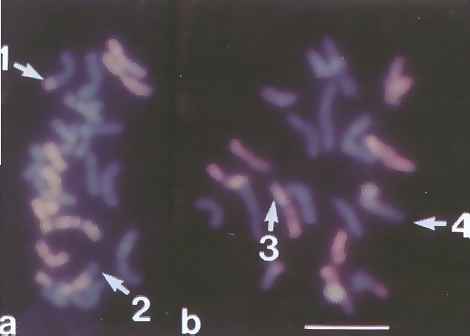| PLANT TISSUE CULTURE
CASE STUDY 1 Utilising anther culture to select for cold hardiness |
||
| INTRODUCTION WHAT IS IT? USES CASE STUDY 1 Anther culture for cold hardiness CASE STUDY 2 CASE STUDY 3
|

Variation in general vigour of anther culture derived plants in the field. Crosses between distantly related species can bring together novel gene combinations. However, the hybrid offspring can be few in number, genetically unstable and require years of further selection and screening before any advantageous characteristics can be brought near to commercial use. Anther culture (androgenesis), to generate haploid plants from pollen microspores, is one way to shorten this process. It allows novel allele combinations, particularly ones involving recessive characters, to be assessed in intact plants. Useful individuals can then be developed into homozygous and fertile plants through chromosome doubling techniques, and brought into a breeding programme. We have recently been involved in a collaborative project with the Institute of Grassland and Environmental Research (IGER) to use this approach to improve cold-tolerance and fodder quality in grazing grasses. Crosses between Lolium multiflorum ( Italian ryegrass) and Festuca arundinacea (tall fescue) should offer valuable combinations of characteristics. The Lolium species should provide good growth characteristics, while the Festuca provides stress-tolerance. One hybrid individual (Festulolium) resulting from such a cross had already shown drought-tolerance characteristics. However, the out-breeding nature of these grass species, along with the hexaploid genome of F. arundinacea and autotetraploid L. multiflorum indicated that a lengthy breeding programme might be necessary. The research project therefore aimed to produce androgenic plants from the existing pentaploid Festulolium plant and assess them for cold tolerance. This exploited the expertise in tissue culture at the University of Liverpool together with experience in breeding for stress-tolerance at IGER. Anthers containing immature pollen (microspores) are the starting material for androgenesis. Flowers have to be selected at the correct developmental stage, which varies from species to species. In addition, some individual genotypes may not be amenable to anther culture, or require specific pretreatments. Careful microscopy and testing of successful pre-treatments of related species are therefore necessary when dealing with a new species. For the Graminae, microspores must be at the mononucleate stage and no pre-treatment is necessary. The cut flowers were surface sterilised and opened in sterile conditions under a binocular microscope. The anthers were dissected and transferred to a solid nutrient medium. Large numbers could be placed on each petri dish. Callus developed, which was transferred to a different medium to initiate embryos and so generate haploid plants. Over 200 androgenic plants were produced at Liverpool, each originating from a different microspore. Each therefore represented a genetically different individual. Testing for phosphoglucosisomerase, where a different isozyme was contributed by each of the five chromosome groups within the Festulolium plant, indicated that the pollen-derived plants had a wide variety of chromosome combinations from each of the parents of the hybrid. The freezing-tolerance of these plants varied considerably, with three individuals able to survive the extreme cold of -14 degrees Celsius. When the chromosome complement of two of these plants was examined using genomic in situ hybridisation (GISH), they carried virtually the whole genome of F. pratensis, a parent of F. arundinacea noted for its freezing-tolerance. Unfortunately, the fertility of these two plants was not restored by chromosome doubling, so that they could not be used for further breeding. However, they demonstrated the potential of androgenesis for rapid assessment of the genetic potential available from a difficult breeding combination, indicating that this type of wide cross revealed characters of cold and drought tolerance that were worth pursuing.
For publications describing this work, follow this link. To return to the top of this page , follow this link |
